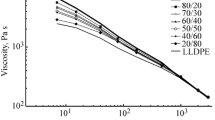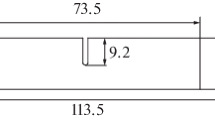Abstract
The tensile behaviour of linear polyethylene was examined over a wide range of temperatures. Samples were prepared from low and medium molecular weight polymer with different morphologies, by varying the initial crystallization conditions. It was found that the temperature of the ductile-brittle transition was markedly different for different samples. In particular, low molecular weight polymer crystallized at a low degree of of supercooling, showed brittle behaviour over most of the temperature range, with a ductile-brittle transition near to room temperature. Rapidly quenched material, where the degree of supercooling is high, showed a very low ductile-brittle transition temperature, especially in high molecular weight polymer. The reasons for these differences in behaviour are discussed both at a phenomenological level and in terms of known structural differences between the different materials examined.
Similar content being viewed by others
References
M. K. V. Chan andJ. G. Williams,Polym. Eng. Sci. 21 (1981) 1026.
R. W. Truss, R. A. Duckett andI. M. Ward,J. Mater. Sci. 16 (1981) 1689.
G. Capaccio andI. M. Ward,Polymer 15 (1974) 233.
Idem, ibid. 16 (1975) 239.
G. Capaccio.T. A. Crompton andI. M. Ward,J. Polymer Sci. Polymer Phys. Ed. 14 (1976) 1641.
P. D. Coates andI. M. Ward,J. Mater. Sci. 15 (1980) 2897.
G. Capaccio, I. M. Ward, M. A. Wilding andG. W. Longman,J. Macromol. Sci. Phys. B15 (1978) 381.
N. Brown andM. Parrish,J. Polymer Sci. Polymer Lett. Ed. 10 (1972) 777.
I. M. Ward, “Mechanical Properties of Polymers”, 1st edn (Wiley, London, 1971).
J. R. Kastelic andE. Baer,J. Macromol. Sci. Phys. B7 (1973) 679.
D. C. Bassett andA. M. Hodge,Proc. Roy. Soc. London A377 (1981) 25.
D. C. Bassett, A. M. Hodge andR. H. Olley,Faraday Discuss. Chem. Soc. 68 (1979) 218.
J. Dlugosz, G. V. Fraser, D. Grubb, A. Keller, J. A. Odell andP. L. Goggin,Polymer 17 (1976) 471.
D. K. Backman andK. L. Devries,J. Polymer Sci. A17 (1969) 2125.
J. M. Haudin, “Plastic Deformation of Semicrystalline Polymers” Spring School on Plastic Deformation of Polymers, Les Houches, April (1982).
A. Peterlin,Kolloid Z.u. Polymere 233 (1969) 857.
J. Peterman, W. Kluge andH. Gleiter,J. Polymer Sci. Polymer Phys. Ed. 17 (1979) 1043.
E. Kamei andN. Brown, private communication on research at University of Pennsylvania (1982).
A. Kelly, “Strong Solids”, 2nd edn (Clarendon Press, Oxford, 1973) p. 10.
I. M. Ward (ed.) “Advances in Oriented Polymers 1” (Applied Science Publishers, London, 1982) Ch. 5.
Author information
Authors and Affiliations
Rights and permissions
About this article
Cite this article
Brown, N., Ward, I.M. The influence of morphology and molecular weight on ductile-brittle transitions in linear polyethylene. J Mater Sci 18, 1405–1420 (1983). https://doi.org/10.1007/BF01111960
Received:
Accepted:
Issue Date:
DOI: https://doi.org/10.1007/BF01111960




